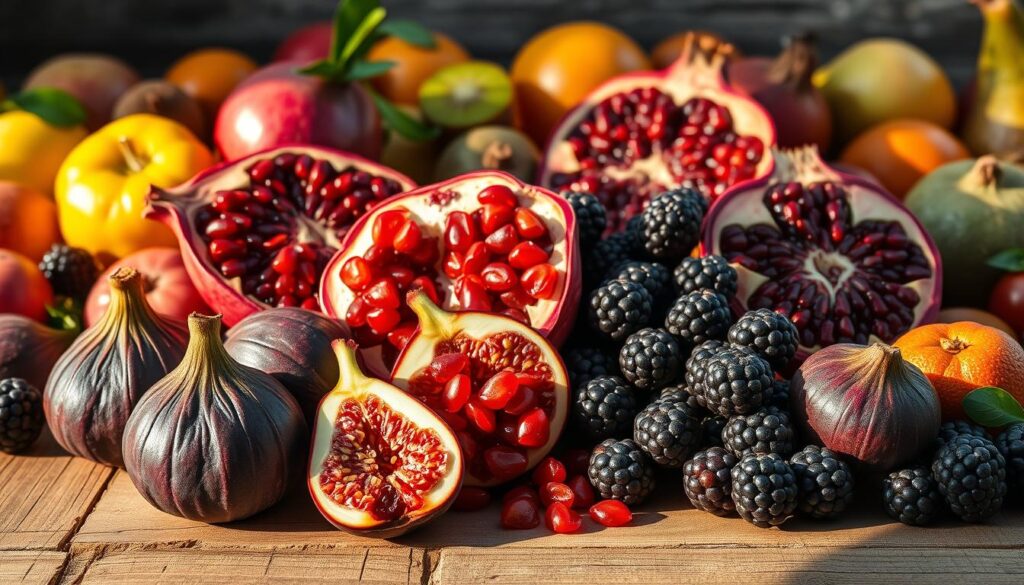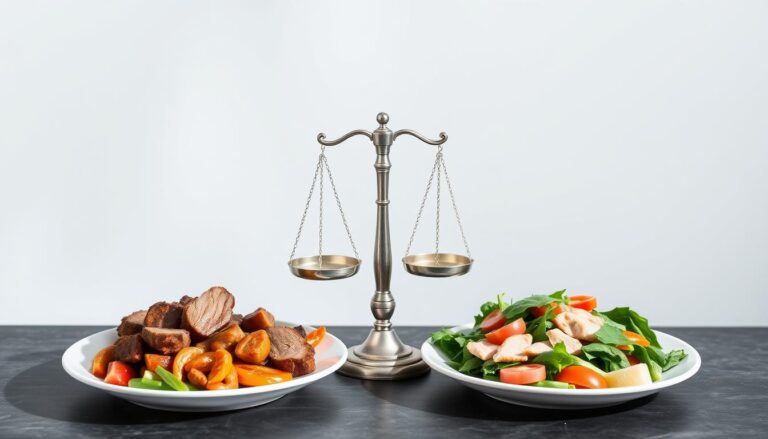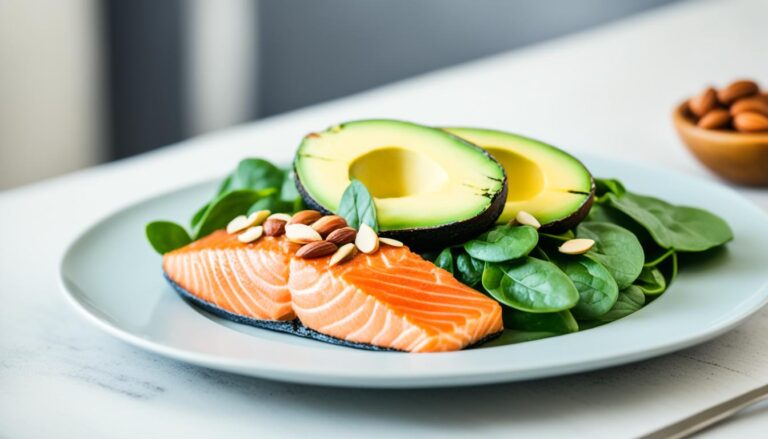Imagine filling your plate with ingredients that naturally balance blood sugar effortlessly improve digestion, and strengthen your heart.
You might be surprised to learn these powerhouse options aren’t exotic superfoods they’re likely sitting in your local supermarket right now.
This guide reveals nature’s multitaskers ordinary items with extraordinary benefits. We’ve identified selections that deliver both soluble and insoluble fiber, plant-based proteins, and protective antioxidants. Unlike restrictive diets, these choices work with your lifestyle, not against it.
Key Takeaways
- Specific foods address blood sugar management and cardiovascular support simultaneously
- Combination of soluble/insoluble fibers enhances digestive health
- Plant-based proteins rival animal sources in nutritional value
- Antioxidant-rich options reduce inflammation naturally
- Practical meal integration strategies for lasting results
Our analysis goes beyond basic nutrition facts. You’ll discover exactly how certain fruits interact with gut bacteria, why particular legumes outperform meat in protein quality, and which fiber types actively lower cholesterol. We’ve included precise measurements to help tailor portions to your needs.
The best part? These solutions require no special equipment or hard to find ingredients. From breakfast smoothies to hearty dinners, you’ll learn adaptable ways to boost meals you already enjoy. Let’s explore how strategic food choices can become your simplest path to feeling your best.
Introduction to Nutritious Daily Foods
Think about how your body feels after a meal that truly nourishes you. Balanced eating isn’t about strict rules it’s about creating harmony between what you crave and what your cells need to thrive. The right mix of ingredients acts like a toolkit, repairing tissues, powering your brain, and shielding you from daily stressors.

Why Your Body Craves Variety
Every bite delivers building blocks for energy and recovery. Soluble fiber forms a protective gel in your gut, slowing sugar absorption. Insoluble types keep things moving smoothly. Together, they’re nature’s cleanup crew lowering cholesterol and stabilizing energy crashes.
The Dynamic Duo Plants Proteins
Legumes like lentils do double duty. They pack more protein per cup than an egg while delivering iron and zinc. Pair them with vitamin C-rich tomatoes, and you boost mineral absorption by 50%. This synergy turns simple meals into nutrient powerhouses.
Research shows diets rich in these combos reduce inflammation markers by 30% in eight weeks. They also feed beneficial gut bacteria that produce mood regulating compounds. It’s not just about eating healthy it’s about choosing foods that work harder for you.
Discovering 10 Healthy Foods Daily Fruits and Legumes Fiber and Protein
Picture your meals doing double duty satisfying hunger while building better health. The items we’ve curated work like nature’s Swiss Army knives, delivering multiple advantages in every bite. They’re pantry staples transformed into wellness tools through smart pairing and preparation.
Overview of Nutritional Benefits
These selections shine because they combine two crucial elements: gut-friendly fiber and muscle supporting protein. Adults need 25-30 grams of fiber daily about what you’d get from three cups of raspberries and a bowl of lentils. Active folks should target 20-30 grams of protein per meal to maintain energy and recovery.
Beyond basic numbers these picks deliver compounds your body craves. Think magnesium for nerve function potassium for blood pressure control, and B vitamins for energy conversion. Many contain plant chemicals that fight cellular damage like anthocyanins in dark berries or quercetin in apples.
What makes these options stand out? Their synergistic effects. Soluble fiber teams up with proteins to slow digestion, keeping you fuller longer. Prebiotics in garlic and onions feed probiotics in yogurt creating a thriving gut ecosystem. It’s nutritional teamwork at its finest.
Incorporate them into omelets, grain bowls, or snacks. Roast chickpeas for crunch, blend spinach into smoothies, or top oatmeal with chia seeds. Each choice moves you closer to daily targets while tasting genuinely satisfying no willpower required.
Fresh Fruits for Fiber and Vitamins
Your favorite fruits might be doing more for you than just satisfying a sweet tooth. These natural wonders combine essential nutrients with delicious flavors, offering an easy way to meet daily nutritional goals while enjoying every bite.

Top Picks for Digestive Support
Pears with skin deliver nearly 3 grams of fiber per half-fruit, making them ideal for smooth digestion. Strawberries pack 2 grams of fiber per half-cup alongside vitamin C and manganese perfect for immune support.
Apples remain a classic choice, providing 3-4 grams of fiber through both soluble and insoluble varieties. Raspberries outshine others with 3.3 grams per cup, while bananas offer potassium and steady energy release.
Beyond Basic Nutrition
Avocados redefine what fruit can achieve, delivering 10 grams of fiber alongside heart-healthy fats. Their unique mix of vitamins E and B supports skin health and energy metabolism simultaneously.
These options do more than fill your stomach. They help regulate blood sugar, reduce inflammation and feed beneficial gut bacteria. Pair them with proteins or whole grains for meals that keep you energized for hours.
Vegetable Options for Dietary Fiber
Ever wonder how your plate can become a powerhouse of nutrients with just a few colorful additions? Vegetables offer more than vibrant meals – they’re nutritional multitaskers that tackle digestion immunity, and energy levels simultaneously.

Beyond Basic Greens
Carrots shine in versatility half a cup cooked delivers 2.3g fiber, while raw sticks provide crunch with 2g per carrot. Their orange hue comes from beta carotene, which converts to vision supporting vitamin A. Beets bring unexpected perks: 2g fiber per 100g plus nitrates that may boost workout stamina.
Broccoli earns its superfood status. A half cup cooked portion offers 2.5g fiber while chopped raw florets add 2.6g protein per cup. Its sulforaphane compounds activate detox enzymes nature’s cellular cleanup crew.
Artichokes dominate the fiber charts with 9.6g per cooked cup nearly half your daily need. Brussels sprouts pack 6.4g per cooked cup alongside vitamin K for bone health. Sweet potatoes balance comfort and nutrition: 6.4g fiber per cooked cup plus potassium for blood pressure support.
These options prove dietary choices needn’t be bland. Roast carrots with cumin blend beets into hummus, or stuff artichokes with garlic herb breadcrumbs. Each bite becomes an opportunity to nourish your body while delighting your taste buds.
Legumes Rich in Fiber and Protein
What if your pantry held the secret to staying full and energized for hours? These humble kitchen staples deliver dual-action nutrition combining gut friendly roughage with muscle supporting plant proteins in every spoonful.
Half a cup of cooked lentils packs a punch with 7.8g fiber and 9g protein. Black beans follow closely, offering 8g fiber and 7g protein per serving. These numbers aren’t just impressive – they’re practical solutions for busy lives.
Kitchen Champions for Every Meal
Transform split peas 8.2g fiber/half cup into creamy soups that fight afternoon slumps. Kidney beans 5.7g fiber become taco fillings that keep you satisfied till dinner. Chickpeas shine beyond hummus roast them with paprika for crunchy salad toppers.
Try these simple swaps:
- Swap rice with lentils in meatloaf for extra texture
- Blend white beans into pasta sauces for creaminess
- Use mashed black beans as burger patty bases
Meal prep becomes effortless when you batch-cook these nutritional powerhouses. Store cooked varieties in freezer portions for instant upgrades to grain bowls stir fries, or breakfast scrambles. Your body gets sustained fuel while your taste buds stay entertained.
Whole Grains and Seeds Oats Quinoa Chia
Ever considered how a simple swap in your pantry could boost your energy all day? These kitchen staples work like miniature nutrition factories, delivering both immediate fuel and long-term health benefits. Their secret lies in balancing fiber density with plant-powered proteins.
Nutritional Powerhouses Unlocked
Rolled oats offer 10.4g fiber per 100g mostly from cholesterol-managing beta-glucan. Half a cup packs 5.5g protein, perfect for stabilizing morning energy. Quinoa stands out among grains, providing 8g fiber and all nine essential amino acids per cooked cup.
Small Seeds Big Impact
Chia seeds transform liquids into nutrient gels just one tablespoon delivers 4.1g fiber. Their soluble fiber content triples when soaked, creating a pudding like texture. Sprinkle them on yogurt or blend into smoothies for effortless crunch.
These options prove smart eating isn’t complicated. Swap rice for quinoa in stir fries bake oats into energy bites or stir chia into overnight mixtures. Your body gets sustained nourishment while your taste buds stay engaged no drastic changes required.





